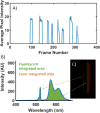Multimode smartphone biosensing: the transmission, reflection, and intensity spectral (TRI)-analyzer
- PMID: 28752875
- PMCID: PMC5614857
- DOI: 10.1039/c7lc00633k
Multimode smartphone biosensing: the transmission, reflection, and intensity spectral (TRI)-analyzer
Abstract
We demonstrate a smartphone-integrated handheld detection instrument capable of utilizing the internal rear-facing camera as a high-resolution spectrometer for measuring the colorimetric absorption spectrum, fluorescence emission spectrum, and resonant reflection spectrum from a microfluidic cartridge inserted into the measurement light path. Under user selection, the instrument gathers light from either the white "flash" LED of the smartphone or an integrated green laser diode to direct illumination into a liquid test sample or onto a photonic crystal biosensor. Light emerging from each type of assay is gathered via optical fiber and passed through a diffraction grating placed directly over the smartphone camera to generate spectra from the assay when an image is collected. Each sensing modality is associated with a unique configuration of a microfluidic "stick" containing a linear array of liquid chambers that are swiped through the instrument while the smartphone captures video and the software automatically selects spectra representative of each compartment. The system is demonstrated for representative assays in the field of point-of-care (POC) maternal and infant health: an ELISA assay for the fetal fibronectin protein used as an indicator for pre-term birth and a fluorescent assay for phenylalanine as an indicator for phenylketonuria. In each case, the TRI-analyzer is capable of achieving limits of detection that are comparable to those obtained for the same assay measured with a conventional laboratory microplate reader, demonstrating the flexibility of the system to serve as a platform for rapid, simple translation of existing commercially available biosensing assays to a POC setting.
Figures









Similar articles
-
A smartphone-based colorimetric reader for bioanalytical applications using the screen-based bottom illumination provided by gadgets.Biosens Bioelectron. 2015 May 15;67:248-55. doi: 10.1016/j.bios.2014.08.027. Epub 2014 Aug 19. Biosens Bioelectron. 2015. PMID: 25168283
-
A multichannel smartphone optical biosensor for high-throughput point-of-care diagnostics.Biosens Bioelectron. 2017 Jan 15;87:686-692. doi: 10.1016/j.bios.2016.09.021. Epub 2016 Sep 9. Biosens Bioelectron. 2017. PMID: 27631683
-
Smartphone spectrometer for colorimetric biosensing.Analyst. 2016 May 23;141(11):3233-8. doi: 10.1039/c5an02508g. Analyst. 2016. PMID: 27163736
-
Smartphone-based analytical biosensors.Analyst. 2018 Nov 5;143(22):5339-5351. doi: 10.1039/c8an01269e. Analyst. 2018. PMID: 30327808 Review.
-
Automatic smartphone-based microfluidic biosensor system at the point of care.Biosens Bioelectron. 2018 Jul 1;110:78-88. doi: 10.1016/j.bios.2018.03.018. Epub 2018 Mar 21. Biosens Bioelectron. 2018. PMID: 29602034 Review.
Cited by
-
Several Probes Derived from Tetraphenyl Ethene and Triphenylamine for Cu(II) and Intracellular Carbon Monoxide Sensing.ACS Omega. 2025 May 18;10(21):21250-21261. doi: 10.1021/acsomega.4c10587. eCollection 2025 Jun 3. ACS Omega. 2025. PMID: 40488007 Free PMC article.
-
Portuino-A Novel Portable Low-Cost Arduino-Based Photo- and Fluorimeter.Sensors (Basel). 2022 Oct 18;22(20):7916. doi: 10.3390/s22207916. Sensors (Basel). 2022. PMID: 36298268 Free PMC article.
-
Analysis of Paper-Based Colorimetric Assays With a Smartphone Spectrometer.IEEE Sens J. 2019 Jun 15;19(2):508-514. doi: 10.1109/JSEN.2018.2876631. IEEE Sens J. 2019. PMID: 31579394 Free PMC article.
-
Robust Smartphone Assisted Biosensing Based on Asymmetric Nanofluidic Grating Interferometry.Sensors (Basel). 2019 May 3;19(9):2065. doi: 10.3390/s19092065. Sensors (Basel). 2019. PMID: 31058818 Free PMC article.
-
Developments in Transduction, Connectivity and AI/Machine Learning for Point-of-Care Testing.Sensors (Basel). 2019 Apr 23;19(8):1917. doi: 10.3390/s19081917. Sensors (Basel). 2019. PMID: 31018573 Free PMC article.
References
-
- Frost & Sullivan. Global Battery Market for Wearables. 2016
-
- Soper SA, Brown K, Ellington A, Frazier B, Garcia-Manero G, Gau V, Gutman SI, Hayes DF, Korte B, Landers JL, Larson D, Ligler F, Majumdar A, Mascini M, Nolte D, Rosenzweig Z, Wang J, Wilson D. Biosens Bioelectron. 2006;21:1932–1942. - PubMed
-
- Kirkwood J. The Next Step for Molecular Point-of-Care Testing. 2016
-
- Bissonnette L, Bergeron MG. Clinical Microbiology and Infection. 2016;16:1044–1053. - PubMed
-
- Chin CD, Linder V, Sia SK. Lab Chip. 2012;12(12):2118–34. - PubMed
Publication types
MeSH terms
Substances
Grants and funding
LinkOut - more resources
Full Text Sources
Other Literature Sources

